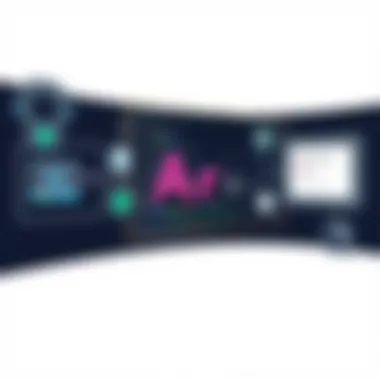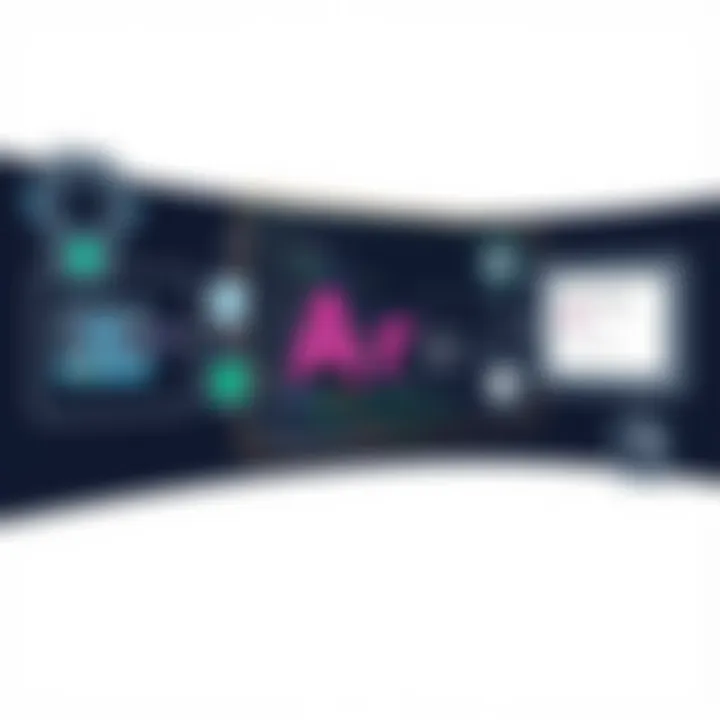Harnessing C# for Augmented Reality Development


Intro
In the ever-evolving landscape of technology, the combination of augmented reality (AR) and C# programming stands as a testament to innovation. This junction is where creativity meets technical skill, enabling developers to craft immersive experiences that transcend traditional application limits. But what exactly does this fusion mean for the software development world? Let's take a closer look.
Augmented reality, merely put, enhances our perceptions of the real world by overlaying digital elements onto it. Using C#, a versatile programming language widely employed in various tech domains, developers can harness the power of AR to create applications that interlace the virtual with the tangible. As professionals journey through this article, they will unravel fundamental concepts and practical methodologies that guide AR development with C#.
Just like a painter blends colors on a canvas to create a masterpiece, developers use frameworks and libraries to shape their AR visions. Important topics such as industry best practices, real-world case studies, and emerging trends will be discussed, putting readers right at the cutting-edge of AR innovation. This isn't just about theoretical knowledge; it’s a roadmap paved with actionable insights and concrete steps to navigating the complexities of this fascinating field.
As we embark on this exploration, it's vital to understand not just the tools we'll employ but also the far-reaching implications of our creations. The technology doesn't just augment reality; it has the potential to change how we interact with information, design user experiences, and even conduct business. From gamification applications to medical training simulations, the possibilities are endless.
In essence, this article aims to equip software developers, IT professionals, data scientists, and tech enthusiasts with a comprehensive understanding of how to leverage C# for innovative AR solutions. So, let's dive in and see what treasures lie within this powerful intersection of technology!
Understanding Augmented Reality
Augmented reality, often abbreviated as AR, has emerged as a pivotal technology in recent years, straddling the line between our real world and the digital domain. Its importance in this article cannot be overstated; understanding augmented reality sets the stage for the deeper exploration of how C# can be utilized to develop immersive experiences. By integrating computer-generated images with the physical world, AR opens up avenues for innovation across various sectors, not only enhancing user interactions but also revolutionizing conventional practices.
In grasping the core principles of AR, one must consider its benefits, such as improved engagement and enhanced learning experiences. As technology rapidly evolves, the tools and frameworks available for creating AR applications have also matured. This article will dive into those aspects, offering insights into how developers can leverage C# for creating impactful AR solutions.
Definition and Key Concepts
At its core, augmented reality refers to the technology that overlays digital content on the real world. It's like putting a digital pair of glasses on your reality—where data, images, or videos can transform how we perceive our surroundings. Consider an artist using AR to visualize how a sculpture might look in a specific location before physically crafting it. This is just one example of how AR can enhance creativity and decision-making.
Key concepts associated with AR include:
- Interactivity: Users are not just passive observers; they can interact with the digital elements integrated into their physical environment.
- Integration: Successful AR implementations blend seamlessly with reality. This means high accuracy in tracking and synchronization with the user’s viewpoint.
- Context Awareness: Augmented reality applications often utilize real-time data to provide contextual overlays that boost the relevance of the digital content.
Types of Augmented Reality
Understanding the different types of AR is essential, as they dictate how applications interact with the real world.
Marker-based AR
Marker-based AR employs a camera and visual markers—think barcodes or QR codes—recognized by the software to produce augmented content. When the camera detects the marker, it triggers a digital overlay which can be text, animations, or 3D models. This type of AR is popular because it is straightforward in implementation and requires minimal hardware. However, it relies heavily on the presence of markers, which can restrict its usability in certain environments.
Markerless AR
On the flip side, Markerless AR doesn't depend on visual anchors but instead utilizes GPS, accelerometers, and compass data to position 3D objects in the real world. This flexibility allows it to be used in various contexts, particularly in mobile applications. A standout feature here is its ability to work in real-time, providing users with a more natural experience. Nevertheless, the reliance on precise sensor data can sometimes lead to inaccuracies in placement, making accuracy a key consideration in design.
Projection-based AR
Then we have Projection-based AR, which employs a projector to cast digital images onto physical objects. This method can be especially effective in collaborative settings where multiple users need to engage with the same digital content simultaneously. It’s beneficial for visualizing concepts such as architectural designs directly onto a surface. However, the setup can be more complicated compared to marker-based or markerless approaches, requiring additional equipment and careful calibration.
Applications of Augmented Reality
The applications of augmented reality span multiple industries, each harnessing this technology's unique capabilities to enhance experiences and streamline processes.
Industrial Applications
Industries have found unique applications for AR, particularly in maintenance and repair. For instance, technicians can utilize AR overlays to see schematics or instructions directly on a machinery part they are working on. This directional guidance significantly enhances operational efficiency and accuracy, reducing the potential for human error.
Education and Training
Augmented reality is also transforming education and training programs. By simulating real-world conditions, it allows students to engage interactively with the material. Imagine nursing students practicing procedures on a digital patient rather than a mannequin; the benefits for skills acquisition are compelling. While this interactivity is a major advantage, the technology requires robust planning and investment to develop practical applications.
Entertainment and Gaming
AR has surged in popularity within the entertainment and gaming industry. Games like Pokémon GO have demonstrated how virtual elements can encourage players to explore their surroundings. This type of application not only draws users in but also creates shared experiences among players. That said, balancing the virtual and real worlds poses a challenge to maintain user immersion without overwhelming them.
In summary, understanding augmented reality reveals a rich landscape of opportunities and challenges that developers must navigate, especially when using tools like C# to build effective applications. As we continue to explore the relationship between augmented reality and C#, it’s crucial to appreciate these foundational elements.
Prologue to


In today's tech-driven world, the role of programming languages has become paramount, especially in bridging the gap between complex applications and user experiences. C# stands out as a significant player in this arena, particularly when it comes to augmented reality (AR) development. This robust language, developed by Microsoft, offers several features that cater specifically to creating rich, immersive AR experiences. With its object-oriented nature, C makes it easier for developers to manage and manipulate the intricate components required in AR applications.
Understanding C# is critical for anyone looking to venture into the realm of AR development. It provides the foundation upon which various prototypes can be built and scaled. As you delve into this article, you'll discover how C integrates seamlessly with prominent frameworks and libraries designed for AR, allowing for rapid development and deployment of interactive apps.
Overview of
Programming Language
C# is a modern, high-level programming language that blends simplicity and power, making it both accessible for beginners and versatile for seasoned developers. Originating from the .NET framework, C emphasizes type safety and ease of use, promoting clarity over complexity. This balance is essential in AR development, where clarity in code correlates with better user experiences.
C# supports various programming paradigms, including imperative and functional programming, expanding its utility across diverse projects. Its syntax, reminiscent of C and C++, is structured in a way that allows developers to understand and write code more intuitively. With a vast community and comprehensive resources available online, learning C has never been more straightforward.
and Object-Oriented Programming
Understanding object-oriented programming (OOP) is crucial when developing AR applications with C#. OOP principles enhance the maintainability and scalability of code, two factors that directly influence the longevity and performance of AR projects.
Classes and Objects
In C#, classes serve as blueprints for creating objects, combining data and functionality. This encapsulation of attributes and methods makes classes a powerful tool for structuring AR applications. For example, a class representing a virtual object in space can manage its properties like size, position, and behavior, allowing developers to manipulate multiple instances easily.
A notable characteristic of classes is their ability to encapsulate functionality, enabling developers to implement features without exposing the underlying code to users. This modularity can be incredibly beneficial in AR, as it allows for complex interactive experiences without overwhelming the system with excessive code complexity.
Inheritance
One of the standout features of C# is its support for inheritance, which allows developers to create new classes based on existing ones. This characteristic promotes code reusability, a crucial aspect when iterating on AR designs. For instance, if you have a base class for a general 3D object, you can easily create subclasses for specific types of objects, like cars or animals, inheriting essential attributes and behaviors while adding unique ones specific to those subclasses.
Inheritance not only streamlines development but also enhances code organization, making it easier to manage large-scale projects. However, it's essential to strike a balance, as excessive reliance on inheritance can lead to unnecessary complexity and reduce the clarity of understanding class relationships.
Polymorphism
Polymorphism in C# allows methods to do different things based on the object it is acting upon, even if they share the same name. This means a single method can have various implementations, promoting flexibility and dynamic behavior in AR applications. For instance, you could have a method that interacts differently with a virtual character versus a virtual object, enhancing the interactivity of your AR experience.
The beauty of polymorphism lies in its ability to simplify code and reduce redundancy. By leveraging this feature, developers can create more generic methods that handle a variety of objects, fostering a more efficient coding process. Still, it's important to ensure that the implementation of polymorphism does not overcomplicate the initial design; clarity should always remain a paramount goal.
The design and implementation of C# in AR development is not just about writing code; it's about crafting experiences that push the boundaries of technology and user interaction.
In summary, the introduction to C# is not merely about learning a programming language; it’s about opening the doors to new opportunities in augmented reality. The object-oriented principles underpinning C provide the foundation for building scalable, efficient, and engaging AR applications, cementing its place as a vital tool in any developer's toolkit.
Frameworks for Augmented Reality Development
Augmented Reality (AR) is changing the way we interact with the digital world, and leveraging frameworks specifically designed for AR development can make the process smoother and more efficient. These C# frameworks provide essential tools and libraries that allow developers to focus on creativity rather than getting lost in the technical minutiae. By using these frameworks, developers can tap into advanced functionalities, save time, and create more immersive experiences.
Unity and
Prelims to Unity
Unity is a powerhouse in the realm of game development, but its capabilities extend far beyond just games. One of the key characteristics of Unity is its versatility; whether you’re crafting quiet educational experiences or engaging games, Unity offers a platform where these concepts can come to life. Its user-friendly interface allows developers to visualize the components they're working on, making it an intuitive choice for both newcomers and seasoned pros.
The unique feature of Unity that stands out is its robust asset store. This library is packed with ready-made models, sound clips, and entire environments that can save countless hours of work. However, while this bounty is a blessing, it's crucial for developers to discern which assets suit their project well, as not all are created equal. For AR developers, Unity’s strong community support means that finding solutions to problems is often just a forum post away.
Setting Up Unity for AR Development
Setting up Unity for AR development is a vital step that lays the groundwork for what’s to come. The key characteristic here is that Unity has made it increasingly easy to integrate AR functionalities. For instance, with its dedicated AR Foundation framework, developers can write once and deploy on multiple platforms, like iOS and Android. This compatibility is a frequently praised aspect.
The unique feature of this setup process is how seamless it is. Unity provides step-by-step guides, which are beneficial especially for AR newbies who may feel overwhelmed. Yet, it's worth staying alert to some pitfalls, such as ensuring your project's settings align properly with the AR feature set you're intending to use, which can sometimes trip up even experienced developers.
Vuforia with
Vuforia SDK Overview


Vuforia is a heavyweight in the AR space, honing its craft for more than a decade. Developers gravitate towards Vuforia for its ability to recognize a wide array of targets - from images to complex 3D objects. The key characteristic of Vuforia is its powerful image recognition capabilities, which can differentiate it from other AR platforms. This makes it a go-to for developers who require advanced tracking features.
A noteworthy feature of Vuforia is its cloud recognition service. This allows for asset management on the web, which means updates can happen without users having to download new versions of the app. However, it’s essential to understand the limits on free usage, as it can quickly escalate to premium tiers if you're planning extensive deployments.
Integrating Vuforia with Unity
The integration of Vuforia with Unity is straightforward, and that’s a huge plus. Developers can channel the power of both through a well-documented process, allowing for custom AR experiences that are difficult to achieve with either tool alone. The key benefit here is the fluid transition between building in Unity and deploying AR experiences through Vuforia, enabling script interoperability.
Another unique feature is how Vuforia enhances Unity's capabilities. For instance, you can programmatically switch between different camera modes, enhancing the user experience. However, the trade-off might involve some additional learning, as developers need to familiarize themselves with both platforms’ architectures to truly maximize what they can create.
Other
Libraries for AR
AR Foundation
AR Foundation is another strong alternative that can cater specifically to multi-platform AR applications. It stands out due to its cross-platform nature, making it easier for developers to build projects that can run on both iOS and Android without heavy rewriting. Its characteristic ease of use coupled with extensive documentation makes it an appealing choice for both novices and seasoned developers alike.
A unique feature worth noting is its support for both ARKit and ARCore. This means that developers can access functionalities like plane detection and light estimation across devices seamlessly. The disadvantage? Some features may not be fully available or functional across all devices, so thorough testing is essential.
EasyAR
EasyAR is another contender worth exploring, especially for developers looking to ease into AR without the commitment to larger frameworks. Its key characteristic is its lightweight nature, which allows for rapid prototyping and development. For individuals or small teams, this can be a fantastic benefit.
A noteworthy aspect of EasyAR is its visual scripting feature, which can empower less code-savvy developers to get involved in creating AR. That being said, it can also limit experienced developers looking to push boundaries, as they might find constraints that come with simplified interfaces.
In summary, the choice of framework can have significant implications on AR project development. Whether it's Unity’s robust asset store or Vuforia’s advanced image recognition capabilities, each option has distinctive advantages and challenges that developers need to weigh carefully.
Developing AR Applications with
When it comes to creating applications that utilize augmented reality, the role of C# cannot be overstated. As a versatile programming language, C brings a host of functionalities to the table, especially when integrated into frameworks like Unity, which is a well-respected engine for AR development. This section dives into several crucial elements that underscore the significance of developing AR applications through C#.
Benefits of using C# includes its ease of use, strong community support, and rich library of features, which allows developers to craft experiences that are not just engaging but also robust in functionality. Further, the ability to write cross-platform solutions means that AR applications can potentially reach a wider audience without requiring extensive code rewrites. Being familiar with C can open doors for developers, enabling them to tap into a flourishing market as industries increasingly leverage AR technology.
As we go deeper into the specifics, the development of a user interface tailored for AR, the seamless integration of sensors and data, and the implementation of interactive elements are fundamental areas of focus. These elements converging make for applications that are more than just visually appealing—they deliver a meaningful and interactive experience for users.
Designing User Interface for AR
Designing user interfaces (UI) in AR comes with its own set of challenges, primarily because traditional UI elements may not translate well into a 3D space. Therefore, the design must be intuitive; users should engage naturally with the overlaying information that augmented reality provides.
In practical terms, this means balancing visual elements with space, ensuring that neither detracts from the real-world views. Also important is to be mindful about how users will interact with the UI. Touch displays, hand gestures, and even voice commands could be part of the interaction scheme.
Moreover, keeping the UI responsive and adaptable to different devices can enhance the overall experience. An effective AR user interface entices users to engage with the content in a more immersive manner, thus increasing usability.
Integrating Sensors and Data
Meaningful interaction relies heavily on integrating various sensors and data inputs into your AR applications. This opens the door to a myriad of functionalities.
GPS and Compass
A key aspect of using GPS and compass data is their ability to provide location-based context within AR applications. This allows developers to create experiences which can react to a user’s physical positioning—potentially enhancing navigation applications or any geolocation-related AR content.
The advantage of using GPS and compass lies in their accuracy. They can bring real-world relevance to virtual overlays. However, reliance solely on these can lead to challenges; GPS signals may falter in populated areas, while compass calibration could be necessary to maintain orientation. When combined with other data sources, GPS and compass can add a compelling layer of sophistication to AR experiences.
Camera Input
Camera input is instrumental in AR technology, acting as the eyes through which the virtual content interacts with the real world. It captures the environment in real-time and incorporates 3D elements seamlessly into what users are seeing. This real-time processing is critical for creating an immersive experience.
One of the standout features of camera input is its ability to create digital overlays that contribute to spatial awareness. The challenge, however, lies in the need for processing power and the potential lag that can occur in lower-end devices. When optimized, camera integration can create fluid experiences that truly blend the virtual and physical realms.
Implementing Interactivity in AR
Interactive elements are what truly differentiate AR from mere virtual displays. They facilitate user engagement and foster a deeper connection to the augmented experience.


Gesture Recognition
Gesture recognition serves as a bridge between the digital content and the user's commands. By translating physical movements into actions, users can interact with AR elements in a natural fashion. For instance, swiping a hand can lead to scrolling through virtual menus, while pinching could zoom in on objects.
This technology is beneficial as it makes the experience more tactile and instinctive, lowering the learning curve for users. The trade-off, of course, is the accuracy of recognition; incorrect gestures can lead to frustration. Still, when implemented effectively, gesture recognition can enrich the user experience significantly.
Collision Detection
Collision detection is essential in AR applications to establish interaction boundaries between virtual objects and the real world. By understanding where and when an object intersects physically or virtually, developers can create more engaging environments that seem intelligent.
One of its key characteristics is its ability to add realism; an object won’t just float in the air randomly but will interact with its surroundings, creating a believable scenario. Challenges arise in terms of performance, particularly when many objects are involved, which may require optimization techniques to maintain smooth interactions. Still, when used judiciously, collision detection can greatly enhance the depth and immersion of augmented reality applications.
Testing and Debugging AR Applications
When it comes to augmented reality, a smoothly running application is paramount. Testing and debugging AR applications ensures that developers can deliver experiences that are not just functional but engaging. A well-tested AR app can vastly improve user interactions, reduce frustration, and lead to higher retention rates. In an arena where users expect seamless integration of digital elements with the real world, the importance of rigorous testing cannot be overstated.
Robust testing processes assist in identifying and resolving issues early in the development cycle. This results in significant cost savings and can shorten time-to-market. Moreover, debugging helps in fine-tuning performance, thus ensuring that the application performs well on various devices. Given the various complexities involved—such as user interactions, tracking, and the overlay of information—every element must be scrutinized to maintain a satisfactory user experience.
Tools for Testing AR Applications
Several tools can aid developers in testing AR applications effectively. Here are some of the most prominent options:
- Unity Test Framework: A robust tool embedded within Unity for unit and integration testing. Ideal for AR applications developed using Unity, offering in-depth features that help in validating game logic.
- Vuforia Engine Testing Tools: Vuforia provides tools specifically for AR development, including performance testing and analytics features. These can help in understanding user engagement and usage scenarios.
- ARKit and ARCore: Both platforms offer comprehensive debugging tools tailored for their frameworks, enabling developers to simulate and assess various AR scenarios without the need for a physical device.
- Postman: While primarily an API testing tool, it's useful in AR development for confirming that backend services interacting with your AR app are running smoothly.
- Google Analytics: User engagement can be tracked meticulously, offering developer insights into user behavior within AR environments.
These tools not only help in identifying problems but also facilitate a smoother workflow during development by offering instant feedback.
Common Issues in AR Development
When developers dive into augmented reality, they may come across several hurdles that can impact the increasingly complex applications they envision. Some of the more prevalent issues include:
- Tracking Failure: Many AR applications rely heavily on visual tracking for superimposing digital objects onto the real world. Poor lighting, obstructed views, and rapid camera movement can hinder recognition and tracking accuracy.
- Device Compatibility: Different devices can yield various performance levels. Testing across multiple hardware and software configurations is key to ensuring a consistent experience.
- User interaction challenges: Users might misinterpret how to interact with AR elements. Clear instructions and intuitive designs can mitigate this issue.
- Performance Issues: AR applications demand substantial processing power, which can lead to lag or crashes, especially on lower-end devices. Effective optimization techniques are vital to overcome this challenge.
- Content Management: Managing 3D models and associated data can become cumbersome if not handled properly. Size and complexity of assets can lead to loading delays or application bloat.
By understanding these common pitfalls, developers can plan assessments strategically and avoid them during the development phase. Addressing these issues early can make the difference between an application that dazzles and one that disappoints.
Future of Augmented Reality and
The future of augmented reality (AR) combined with C# programming is a topic that holds immense significance in the realm of technology. As the digital landscape evolves, AR emerges as a powerful tool, integrating real-world environments with virtual overlays. This integration not only enhances user experiences but also introduces new capabilities in various sectors. C#, a versatile programming language, plays a crucial role in facilitating AR development by offering robust frameworks and libraries that streamline the process.
Emerging Trends in AR Technology
One cannot ignore the rapid advancements that are shaping the AR industry. The following are key trends that are becoming increasingly prominent:
- Wearable AR Devices: Devices like smart glasses, which overlay information directly onto the user's field of vision, are gaining traction. These devices are anticipated to improve in functionality and affordability, making AR more accessible.
- 5G Connectivity: The rollout of 5G networks is set to revolutionize AR applications. With higher data transfer speeds and reduced latency, experiences will become more seamless and immersive.
- AI-Powered AR: Incorporating artificial intelligence into AR systems could personalize user experiences, providing tailored content based on interactions and preferences.
These emerging trends signify not just a technology shift but also a cultural one, as more individuals and businesses adopt AR in their daily lives.
and Future AR Development Opportunities
C# offers a wealth of opportunities for future AR development, particularly when paired with frameworks like Unity and Vuforia. Some of the potential avenues include:
- Enhanced Collaboration Tools: With remote work becoming the norm, AR can foster collaboration through shared virtual spaces, allowing team members across the globe to interact as if they were in the same room.
- Personalized Marketing Solutions: Businesses can leverage AR to create personalized shopping experiences, allowing customers to visualize products in their own space before making a purchase.
- Advanced Simulation Training: C# can be used to develop AR simulations that train professionals across various fields, such as healthcare or aviation, by immersing them in realistic scenarios.
The adaptability of C# in AR development encourages continuous exploration of potential applications, which is vital for software developers and tech enthusiasts alike.
Industries Poised for AR Growth
Several industries are on the cusp of benefiting significantly from AR technology. Notable sectors include:
- Healthcare: AR can support complex surgical procedures with real-time data overlay and visualizations, enhancing precision and outcomes.
- Education: Through AR, educators can transform traditional learning experiences, making complex subjects like astronomy or anatomy more interactive and engaging.
- Real Estate: Virtual property tours using AR can allow potential buyers to visualize spaces from the comfort of their homes, streamlining the decision-making process.
With the increasing integration of AR into various industries, C# serves as a pivotal tool for developers keen on navigating this expanding landscape. Keeping an eye on these industries and the trends listed can provide a clearer vision of how Augmented Reality might shape our future, not just technologically but socially as well.
"The confluence of augmented reality and robust programming languages like C# will undoubtedly pave the way for innovations that may redefine how we perceive our surroundings."
For further insights on AR advancements, check out Wikipedia on Augmented Reality or visit Britannica.com.
The exploration of Augmented Reality using C# opens the door for developers eager to contribute to a future where boundaries between the digital and physical worlds continue to blur.



